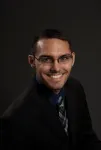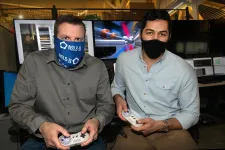Natural Sciences students' research published in prestigious journal
2021-03-25
(Press-News.org) A collaborative research project by team of undergraduate students from the University of Exeter's Natural Sciences department has been published in a prestigious academic journal.
Lewis Howell, Eleanor Osborne and Alice Franklin have had their second-year research published in The Journal of Physical Chemistry B.
Their paper, Pattern Recognition of Chemical Waves: Finding the Activation Energy of the Autocatalytic Step in the Belousov-Zhabotinsky Reaction, was a result of their extended experiment work in the Stage 2 module "Frontiers in Science 2".
Their project involved the Belousov-Zhabotinsky chemical reaction - an example of a chemical oscillator that is often used to illustrate a chaotic system.
These reactions are theoretically important because they show that chemical reactions do not have to be dominated by equilibrium thermodynamic behaviour.
For the research, the team used a Raspberry Pi camera to record images of the reaction over time, and repeated the experiment under a wide range of temperature conditions.
The group were the first to apply a filter-coupled circle finding algorithm and localised pattern analysis to the Belousov-Zhabotinsky reaction in order to extract features such as velocity of the waves.
They were soon able to get exceptionally good experimental results which, coupled with the application of novel image analysis techniques, allowed them to make unprecedented progress, unveiling some peculiar and previously undocumented features of this chemical oscillator.
Lewis said: "The experimental work went really well; we planned all the experiments ourselves and conducted them over five or six weeks of lab time. It's a really interesting chemical reaction, and we had a lot of fun doing it; we found that our data was really good, which gave us a good platform to work from.
"Together we were able to do a lot of cool analysis, using image processing techniques to extract properties such as the velocity of the chemical waves you see in the reaction."
Dr Eric Hébrard, who co-supervised the module alongside Dr. David Horsell, said: "Throughout all this journey, Lewis, Eleanor and Alice have been very comfortable working alongside academic staff as well as together and have displayed engaging and collaborative team-working skills."
Alice added that "Natural Sciences at Exeter is geared towards giving undergraduate students first-hand experience of research." Eleanor also added that "without the course being so interdisciplinary, we couldn't have achieved such a high quality of results that enabled us to publish this paper; it goes to show that collaboration between scientists from different disciplines is a really effective way to approach research."
INFORMATION:
Lewis is currently applying to PhDs and is particularly interested in the field of image analysis, a major component of the paper. Eleanor is also applying to PhDs in the field of photonic sensing. Alice graduated last year and is working at the University of Exeter, as a bioinformatician in a research group at the medical school.
ELSE PRESS RELEASES FROM THIS DATE:
2021-03-25
March 7, 2021, KAUST, Saudi Arabia - KAUST Assistant Professor of Computer Science Mohamed Elhoseiny has developed, in collaboration with Stanford University, CA, and École Polytechnique (LIX), France, a large-scale dataset to train AI to reproduce human emotions when presented with artwork.
The resulting paper, "ArtEmis: Affective Language for Visual Art," will be presented at the Conference on Computer Vision and Pattern Recognition (CVPR), the premier annual computer science conference, which will be held June 19-25, 2021.
Described as the "Affective Language for Visual Art," ArtEmis's user interface has seven emotional descriptions on average for each image, bringing the total count to over 439K emotional-explained attributions from humans on ...
2021-03-25
While urban agriculture can play a role in supporting food supply chains for many major American cities -- contributing to food diversity, sustainability and localizing food systems -- it is unrealistic to expect rooftop gardens, community plots and the like to provide the majority of nutrition for the population of a metropolis.
That's the conclusion of a team of researchers who analyzed the nutritional needs of the population of Chicago and calculated how much food could be produced in the city by maximizing urban agriculture, and how much crop land would be needed adjacent to the city to grow the rest. The study was the first to evaluate land required to meet ...
2021-03-25
Scientists have shown that SARS-CoV-2, the virus that causes COVID-19, can infect specific cells in the salivary gland in the mouth. The study by researchers from the Wellcome Sanger Institute, National Institutes of Health and the University of North Carolina at Chapel Hill, and their collaborators within the Human Cell Atlas Oral & Craniofacial Network, also discovered that live cells from the mouth were found in saliva, and that the virus was able to reproduce within these infected cells.
The study revealed that salivary gland cells could play a role in transmission ...
2021-03-25
Göttingen, March 25, 2021. Testing and vaccination - these are the pillars on which humanity is trying to get a grip on the Coronavirus pandemic. Although it is taking longer than many had expected, it is believed that it is only a matter of time before we are all vaccinated and thus protected. However, time is also working for the virus, which has now mutated several times, with variants B.1.1.7 from the United Kingdom, B.1.351 from South Africa and P.1 from Brazil spreading rapidly. These viruses have mutations in the so-called spike protein, the structure on the surface of the virus that is responsible for attachment to host cells. At the same time, the spike protein is also the major target of the immune response. Antibodies generated in response to SARS-CoV-2 infection or vaccination ...
2021-03-25
Supersized alcopops are ready-to-drink flavored alcoholic beverages with high alcohol content that are disproportionately consumed by underage drinkers. There can be up to 5.5 standard alcoholic drinks in a single 24 ounce can, so consuming only one can of supersized alcopop is considered binge drinking, and consuming two cans can cause alcohol poisoning. Still, these products remain under-regulated and are available inexpensively at gas stations and convenience stores, where they are more readily accessible by underage youth.
New research led by George Mason University's College of Health and Human Services found that nearly ...
2021-03-25
The burial field in Valsgärde outside Uppsala in central Sweden contains more than 90 graves from the Iron Age.
"On a light note, we could say that Valsgärde is Scandinavia's answer to Sutton Hoo in England as portrayed in the film The Dig on Netflix," says Birgitta Berglund, professor emeritus of archaeology at the Norwegian University of Science and Technology's NTNU University Museum.
Valsgärde is especially known for its spectacular boat graves from the 600s and 700s CE. This timeframe is in the middle of what Norway calls the Merovingian period, the era just before the Viking Age.
Two of these spectacular boat graves are at the centre of this story -- or more specifically, the story is really about the down bedding that was found ...
2021-03-25
Oncotarget published "Phase 1 study of Z-Endoxifen in patients with advanced gynecologic, desmoid, and hormone receptor-positive solid tumors" which reported that Z-endoxifen administration was anticipated to bypass these variations, increasing active drug levels, and potentially benefiting patients responding sub-optimally to tamoxifen.
Patients with treatment-refractory gynecologic malignancies, desmoid tumors, or hormone receptor-positive solid tumors took oral Z-endoxifen daily with a 3 3 phase 1 dose escalation format over 8 dose levels.
Three patients had partial responses and 8 had prolonged stable disease; 44.4% of patients at dose levels 6–8 achieved one of these ...
2021-03-25
UPTON, NY — Inspired by the mastery of artificial intelligence (AI) over games like Go and Super Mario, scientists at the National Synchrotron Light Source II (NSLS-II) trained an AI agent – an autonomous computational program that observes and acts – how to conduct research experiments at superhuman levels by using the same approach. The Brookhaven team published their findings in the journal Machine Learning: Science and Technology and implemented the AI agent as part of the research capabilities at NSLS-II.
As a U.S. Department of Energy (DOE) Office of Science User Facility located at DOE’s Brookhaven National Laboratory, NSLS-II enables scientific studies by more than 2000 researchers each year, ...
2021-03-25
Akito Kawahara was snapping pictures at a scenic outlook in Hawaii when he spotted the moth equivalent of a dodo.
An entomologist, Kawahara recognized the squiggly patterns on nearby plants as trails carved by leaf-mining caterpillars and lowered his camera to take a closer look. To his astonishment, he saw a tiny moth most experts assumed was extinct. It belonged to a genus known as Philodoria, a type of moth found only in Hawaii and one that hadn’t been documented in the wild since 1976.
“I thought, ‘Oh my God, there’s a Philodoria ...
2021-03-25
New research shows that consumers judge 'activist brands' based on how morally competent they are perceived to be when challenging free speech.
The report, co-authored by experts at the Business School (formerly Cass), Birkbeck, University of London and the University of Sussex Business School explains that stakeholders draw their conclusions on the biggest brands by measuring three moral skills: sensitivity, vision, and integration.
Lacking these traits, a brand raising controversy is judged as transgressing, reproducing and manipulating the boundaries of free speech. Displaying these traits proves the brand is not merely 'woke-washing' ...
LAST 30 PRESS RELEASES:
[Press-News.org] Natural Sciences students' research published in prestigious journal





